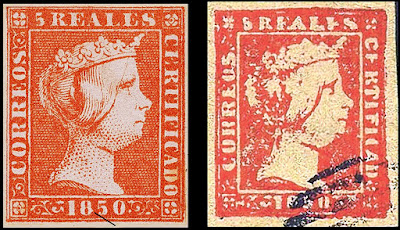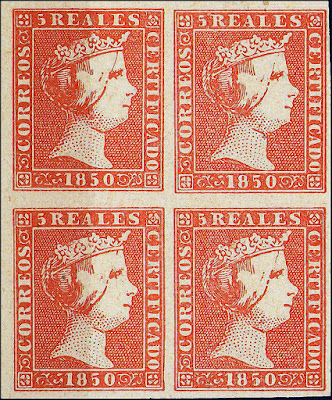NOTE - The Spain general forgeries do not include the Sperati creations
The numerous Spanish Sperati forgeries are all examined in a separate blog
The numerous Spanish Sperati forgeries are all examined in a separate blog
Between 1850 and 1875, Spain issued new stamps in 20 different different years.
This was basically an effort to combat forgeries which resulted in low production numbers, the resulting high collector demand was a great motivator for forgers and completely had the opposite effect on forgeries.
Spanish forgeries were aimed at collectors, especially the rarer issues but most were Postal Forgeries meant to defraud the government.
Up to 1900 I would estimate that some 400 different forgeries exist far outnumbering the genuine issues.
The key difference between Spanish forgeries and those of other countries is their collectability.
They regularly feature on prominent Spanish auctions and can command some surprising amounts as shown with all the forgeries below.
A section of a page from a recent Spanish auction featuring Postal Forgeries
Over 300 lots were up for sale and the prices shown above are a clear example that Postal Forgeries can be very valuable.
The 1850 Stamps Issued
Quantities issued (approximate)
6 cuartos – 6,300,000
12 cuartos – 52,000
5 reales – 48,000
6 reales – 13,000
10 reales – 8,500
6 Cuartos - 2 Plate types exist
Above Type I & II
Genuine features
1. The left frame of the corner element is thick
2. There is a diagonal color stroke in the R
3. There are horizontal dashes in the E
4. There is a blank and sometimes distorted area here
5. A thick color blotch in this corner
6. Background lines are visible in the white frame
7. Notches in the top right frame
8. This dot appears to be fairly consistent.
NOTE – these characteristics are not visible in all types
Forgeries compared to the original
The forgeries of Spain are extremely plentiful and varied.
One can expect 5 to 15+ varieties of each value.
Generally there are 2 types, those that are crude and easily recognized and very dangerous ones that require special attention.
A very dangerous and extremely common type are the Segui forgeries.
Miguel Segui was a Barcelona restaurateur turned forger who produced excellent facsimiles of basically all the Spanish stamps up to the early 20th century.
Most of his forgeries are uncancelled and are known under the name ‘Barcelona forgeries’. He also made forgeries of Cuba, Fernando Po, the Philippines and Porto Rico.
There are vast quantities of his stamps and generally they are in unused condition.
Unused pairs or blocks are often his work.
All the the stamps are compared to the genuine which is always on the left.
6 Cuartos Forgeries
In a Madrid 1997 auction it sold for the equivalent of $85,000 US.
On April 2, 1850 several letters with fake stamps were discovered in the post office of Alicante.
Police investigations concluded with the arrest and prosecution of the culprits. The engraver Francisco Javier Martínez and the printer Vicente Pastor were sentenced to five years in prison and 2,500 pesetas as fine for being the authors of the falsification. Francisco Gomis, a postman in the town, was sentenced to the same penalties and, in addition, to the loss of his employment for distributing the false stamps
The following are VERY crude forgeries that do not require any feature comments
The last one, in a genuine 6 Reales, the queen faces right
F, N & C of FRANCO inclined
Thick letters
Letters are smaller and distorted
Many breaks and white spots
Decent forgery
White framing areas around neck, bust and hair
Overall deceptive but lacks a lot of detail
Deceptive forgery - much better than usual for Torres
Coarse, rough shading
Typical Torres spider fake cancel used on other country forgeries.
Segui is the most prolific forger of Spain up to 1930. Pairs and blocks offered
are often his creations.
- There is a diagonal color stroke in the R – not in the Segui
- There are horizontal dashes in the E – not in the Segui
- There is a blank and sometimes distorted area here – this area is normal in the Segui
- Background lines are visible in the white frame. – the lines do not extend into the frame
- Notches in the top right X frame – there are no notches in the Segui
Most Segui forgeries are without cancels
Printed by typography on thick paper.
1. The crown has several differences
2. The shading lines in the hair are thicker and more pronounced
3 The eye does not have an ellipse underneath.
4 The neck is outlined by a well defined line, whereas in the original it is formed by the grid of the background
5. The ornament to the left of 1850 has 3 spurs on its left side instead of 2
5 Reales Forgeries
Genuine 5 Reales
Note the key feature is the bulge in the lower right of the 8
Note the key feature is the bulge in the lower right of the 8
Fournier forgery
As with other Fournier, he only sold these in all probability
These are quite good.
The major difference is the impossibly large margins but a knowing seller might trim them.
Closer observation will show that the shading and dots are much coarser.
The eyes do not match up.
 |
| Block from the Geneva Fournier Collection |
1. Large space between frames
2. Heavy shaded eyebrow
3. Mouth line is thick and does not curve as much
4. Corner element misshapen
5. No bump on the 8.
6. More white space and broken lines in the hair
2. Heavy shaded eyebrow
3. Mouth line is thick and does not curve as much
4. Corner element misshapen
5. No bump on the 8.
6. More white space and broken lines in the hair
1. Large break above the 5
2. Large top serif on the L
3. Typical white blotch
4. No bulge on the 8
Spiro forgery
2. Large top serif on the L
3. Typical white blotch
4. No bulge on the 8
Very large margins
 |
| P. Winter Pair |
A rather crude attempt
Facial features obviously wrong
Very thick letters
Given the crudeness, I have some doubts that this is a Spiro
6 Reales Forgeries
Genuine 6 Reales
1. The frame lines extend into the white frame
2. There is a break in the bottom right ornament which extends into the white line above.
3. The lower legs of the E’s are longer and the right one has an inclined serif
4. The 5 of 1850 is generally disrupted.
Very crude forgery
Very crude
Thick letters
Corner ornaments different
Large background dots
This is an excellent forgery and has been authenticated
NOTE – There are many of this forgery.
The first E is slanted to the left
The second E has a curved top
The throat lines are short
Torres forgery
There are many differences but the key is the
large letters.
The mouth is small and the ear has little shading
Unlisted forgery
Overall a decent forgery
Large ear
Misshapen nose has a bump
Large letters
NOTE – There are many of this forgery.
The first E is slanted to the left
The second E has a curved top
The throat lines are short
Large margins - a key clue
There are many differences but the key is the
large letters.
The mouth is small and the ear has little shading
Overall a decent forgery
Large ear
Misshapen nose has a bump
Large letters
This has features of a Torres forgery
Segui forgery
Note the small dot of color in the eye
The back neckline is solid
The dash connecting the frame lines is missing
The hair lines are coarser
The tip of the crown comes to a point
Most Segui forgeries are found without cancels
A modern Peter Winter forgery
Most of the letters and numerals do not match
Heavy shading in the eyelid
Broken frame lines
Uneven background
10 Reales Forgeries
This stamp is rare so beware of any offers
Genuine 10 Reales
Note frame line breaks of the original
Note frame line breaks of the original
Fournier forgery
1. The top of the R is slanted
2. The crown details are very different from the original
3. The foot of the R has a hook
4. The hair line is white
5. Missing center section of the cross
 |
| Block from the Geneva Fournier Collection |
Extremely crude and primitive
1. The corner breaks are missing
2. The A has a slanted middle bar
3. The S is larger
4. The hair lines are coarser
5. A break in the frame
6. The nose is more pointed
Segui block
Torres forgery
The small S is larger
The bottom leg of the E’s are not longer
The bottom of the bust does not go into the frame
Typical fake spider cancel
Addendum
 |
| Fournier Essays from the Geneva Collection |













































No comments:
Post a Comment
THANK YOU for the feedback. Your comment will be reviewed and appear on this blog within 24 hours
Do you have any pic to share? Use this code [img]your-image-url-here[/img]